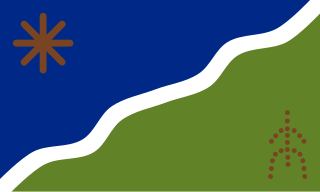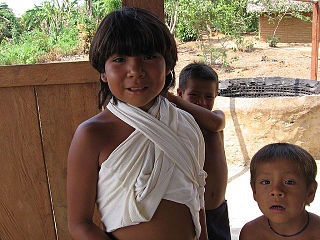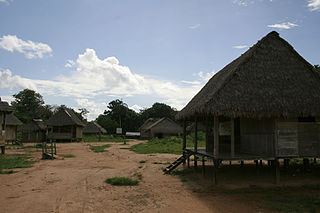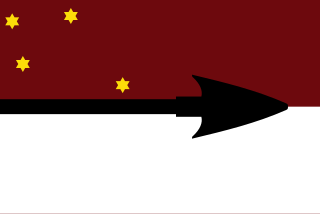 W
WThe Aché are an indigenous people of Paraguay. They are hunter-gatherers living in eastern Paraguay.
 W
WThe Kawésqar, also known as the Alacalufe, Kaweskar, Alacaluf or Halakwulup, are an indigenous people who live in Chilean Patagonia, specifically in the Brunswick Peninsula, and Wellington, Santa Inés, and Desolación islands northwest of the Strait of Magellan and south of the Gulf of Penas. Their traditional language is known as Kawésqar; it is endangered as few native speakers survive.
 W
WThe Araweté are an indigenous people of Brazil. They are swidden horticulturalists native to the state of Pará.
 W
WThe Ayoreo are an indigenous people of the Gran Chaco. They live in an area surrounded by the Paraguay, Pilcomayo, Parapetí, and Grande Rivers, spanning both Bolivia and Paraguay. There are approximately 5,600 Ayoreo people in total. Around 3,000 live in Bolivia, and 2,600 live in Paraguay. Traditionally nomadic hunter-gatherers, the majority of the population was sedentarized by missionaries in the twentieth century. The few remaining uncontacted Ayoreo are threatened by deforestation and loss of territory.
 W
WThe Chamacoco people (Ishír) are an indigenous people of Paraguay. Some also live in Brazil.
 W
WThe Chono people, or Guaiteco were a nomadic indigenous people or group of peoples of the archipelagos of Chiloé, Guaitecas and Chonos.
 W
WThe Ese Ejja are an indigenous people of Bolivia and Peru, in the southwestern Amazon basin. 1,687 Ese Ejja live in Bolivia, in the Pando and Beni Departments, in the foothills along the Beni and the Madre de Dios Rivers. In Peru, they live along the Tambopata and Heath Rivers, near Puerto Maldonado.
 W
WFuegians are one of the three tribes of indigenous inhabitants of Tierra del Fuego, at the southern tip of South America. In English, the term originally referred to the Yaghan people of Tierra del Fuego. In Spanish, the term fueguino can refer to any person from the archipelago.
 W
WThe Haush or Manek'enk were an indigenous people who lived on the Mitre Peninsula of the Isla Grande de Tierra del Fuego. They were related culturally and linguistically to the Ona or Selk'nam people who also lived on the Isla Grande de Tierra del Fuego, and to the Tehuelche people of southern mainland Patagonia.
 W
WThe Huni Kuin are an indigenous people of Brazil and Peru. Their villages are located along the Purus and Curanja Rivers in Peru and the Tarauacá, Jordão, Breu, Muru, Envira, Humaitã, and Purus Rivers in Brazil.
 W
W"Las Vegas culture" is the name given to many Archaic settlements which flourished between 8000 BCE and 4600 BCE.(10,000 to 6,600 BP) near the coast of present-day Ecuador. The name comes from the location of the most prominent settlement, Site No. 80, near the Las Vegas River and now within the city of Santa Elena. The Las Vegas culture represents "an early, sedentary adjustment to an ecologically complex coastal environment."
 W
WThe Machiguenga are an indigenous people who live in the Amazon Basin jungle regions of southeastern Peru, east of Machu Picchu and close to the borders of Bolivia and Brazil. Their population is about 7700. Theirs is a hunter-gatherer culture for the most part, although they also practice slash and burn agriculture. The main crop grown is cassava, and their main source of protein is the paca, a large 6–12 kg (13–26 lb) rodent. During the dry season, the Machiguenga also use fishing to supplement the protein in their diet.
 W
WThe Pai Tavytera are an indigenous people of Paraguay and Brazil. They primarily live in Amambay Department in Paraguay and the Brazilian state of Mato Grosso do Sul.
 W
WPaleo-Indians, Paleoindians or Paleo-Americans, were the first peoples who entered, and subsequently inhabited, the Americas during the final glacial episodes of the late Pleistocene period. The prefix "paleo-" comes from the Greek adjective palaios (παλαιός), meaning "old" or "ancient". The term "Paleo-Indians" applies specifically to the lithic period in the Western Hemisphere and is distinct from the term "Paleolithic".
 W
WThe Selk'nam, also known as the Onawo or Ona people, are an indigenous people in the Patagonian region of southern Argentina and Chile, including the Tierra del Fuego islands. They were one of the last native groups in South America to be encountered by migrant Europeans in the late 19th century. In the mid-19th century, there were about 4000 Selk'nam; by 1919 there were 297, and by 1930 just over 100.
 W
WThe Tacana People are an ethnic group who live in the Beni Department of Bolivia. There were 18,535 of them in 2012, of whom 559 speak the Tacana language natively.
 W
WThe Aónikenk people, also referred to by the exonym Tehuelche, are an indigenous people from Patagonia in South America, with existing members of the group currently residing in the southern Argentina-Chile borders.
 W
WThe Tsimané, also known as the Tsimane' or Chimane, are an indigenous people of lowland Bolivia, living chiefly in the Beni Department municipalities of San Borja, San Ignacio de Moxos, Rurrenabaque, and Santa Ana del Yacuma. The Tsimané are the main residents of the T’simane Council Territory and the Pilón Lajas Reserve. They are primarily a subsistence agriculture culture, although hunting and fishing contribute significantly to many of the settlements' food supply. Those Tsimané living in the Reserve are affiliated with the multiethnic Consejo Regional Tsimane Moseten (CRTM), which holds the title to the Reserve as a Native Community Land or TCO.
 W
WThe Yahgan, also called Yagán, Yaghan, Yámana, Yamana or Tequenica, are one of the indigenous peoples of the Southern Cone, who are regarded as the southernmost peoples in the world. Their traditional territory includes the islands south of Isla Grande de Tierra del Fuego, extending their presence into Cape Horn.
 W
WYaruro people (Pumé) are Circum-Caribbean tribe and indigenous people of Venezuela. They live in the savanna plains of Venezuela called the Llanos, located west of the Orinoco River.